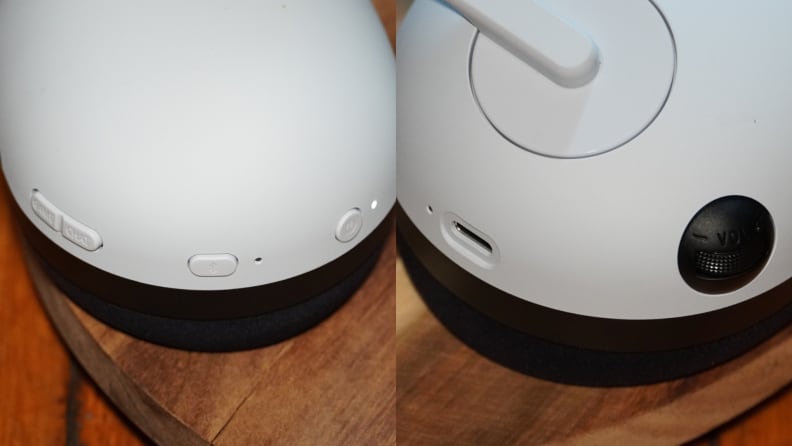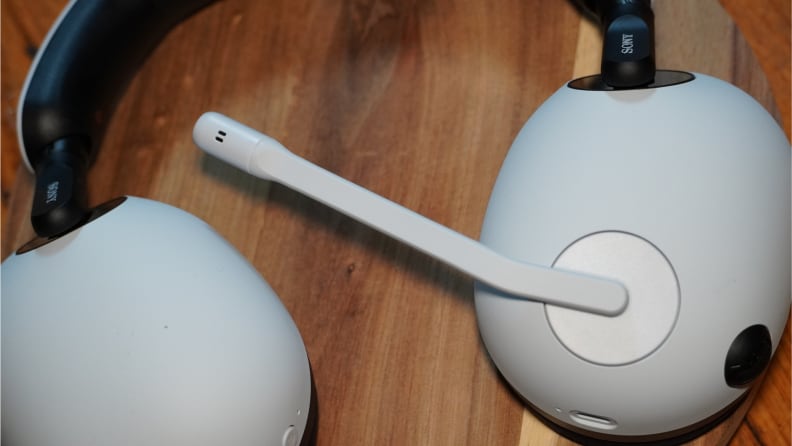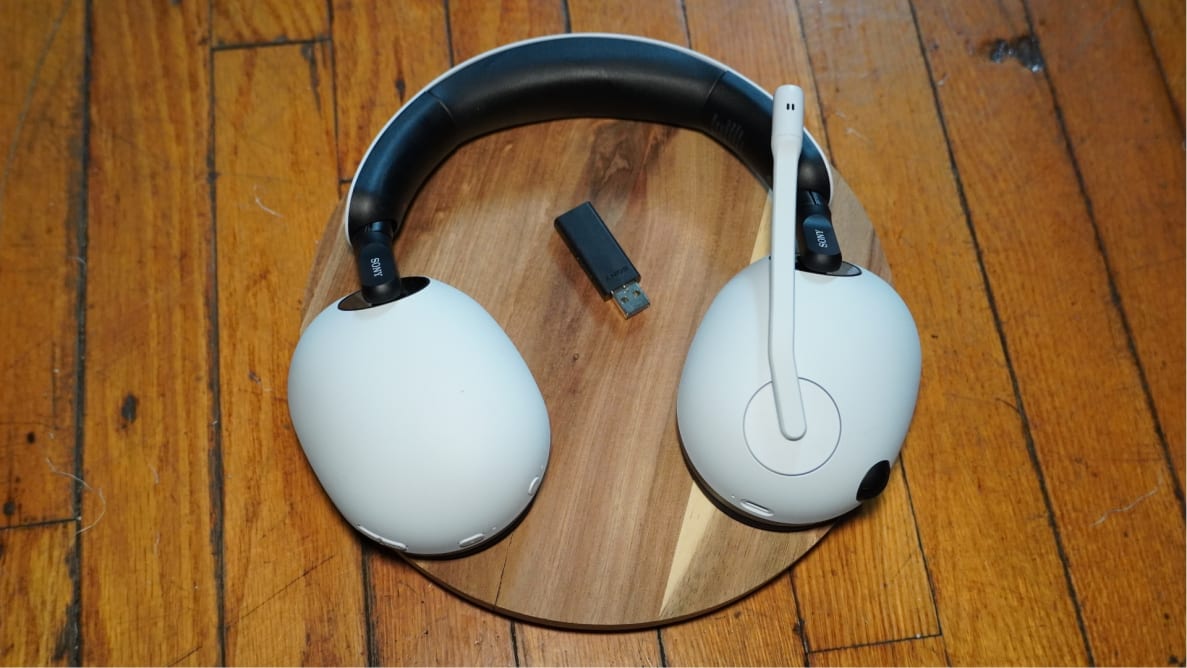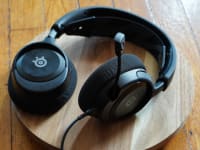Pros
-
Powerful sound
-
Three audio streams
-
Clear mic
Cons
-
Minor signal issues
-
Oversized design
About the Sony Inzone H7

A closer look at the ear pads.
Here are the specs of the headset we tested:
- Cost: $230
- Style: Over-ear, closed-back
- Colors: White with black accents
- Drivers: 40mm drivers
- Connections: 2.4 GHz over USB-A dongle, Bluetooth 5.0
- Battery life: 40 hours
- Device compatibility: PC, PlayStation 5 (2.4 GHz wireless); iPhone, Android, Mac (Bluetooth)
- Microphone: Bidirectional boom microphone, flip-to-mute
- Virtual surround sound: 360° Spatial Audio (Windows Only), Tempest 3D (PS5 only)
- Noise canceling: No
- Weight: 11.1 ounces
The Inzone H7 is very nearly the same headset as Inzone H9 (the two even show up as “Inzone H7 / H9” in Windows), but it lacks active noise canceling and swaps the leatherette ear cups for a fabric finish instead. The lack of ANC comes with a benefit for battery life, up to 40 hours from the H9’s 32 hours. Both models, and Inzone M-series monitors, are adjustable on PC via Sony’s INZONE Hub software.
Sony’s Inzone H7 headset starts off strong with a comfortable fit and easy adjustments. Coming in at over $200, you should expect comfort, though. It’s a bit of a shame that Sony had to make all of its Inzone headsets as large as it did to add the PlayStation 5-inspired style, as they now compete with some massive audiophile headphones on the size front. The non-removable, non-retractable boom mic doesn’t help either.
That disappointment is doubled because Sony included Bluetooth support that would be useful if this was a headset you could comfortably take outside.

Comfort will be the first thing you'll feel with this headset.
Sony has managed to pack in some respectable audio chops, though. Just like the Inzone H9, which the H7 shares most of its design and hardware with, the Inzone H7 shines in its delivery of game audio. The action in Call of Duty: Modern Warfare II is heavy and detailed at once. When hunkered down to defend a hardpoint, the headset provides intelligible surround sound of where enemies are moving, even behind walls, and lets me keep my sights trained on them.
The mic on the H7 is satisfyingly clean. It doesn’t deliver a rich, full voice, but it very successfully focuses on my voice while cutting down on background sounds. My keyboard and mouse clicks don’t come through, nor does fan noise.
The Inzone H7 has connectivity covered, between a 2.4GHz wireless connection over USB-A dongle and Bluetooth 5.0. They can also successfully combine audio from both sources at the same time, which can be convenient, especially for voice chat on consoles. The transmitter splits the audio coming from the PC into two streams (game and chat), allowing for on-the-fly balancing between the two.
It’s a convenient feature that’s held back by the headset’s clunky controls. SteelSeries’ ChatMix dial makes adjustments quick and easy, while the Inzone H7’s buttons are hard to find at a moment’s notice and take longer to tap to find an ideal balance mid-game.
For all the good points the Inzone H7 shares with the H9 headset, it also shares some of the bad. Beyond its design similarities, the wireless connectivity saw the same performance issues. While the headset stays connected and receives audio through my testing in the same room as the transmitter, there are issues with digital artifacts even while just a few feet from the receiver with very little in the way. This isn’t an issue I’ve experienced with almost any other wireless gaming headset.
Should you buy the Sony Inzone H7?
Maybe, if you like the style

If bulky headsets are your thing, then this one's for you.
The Inzone H7’s pricing makes it a lot more palatable than the H9. At $230, it’s less than 80% the price of the H9, a much better value since the H9’s ANC is limited by the fact that you won’t want to travel with it. I’ve even seen it on sale as low as $148. If you really like the style of the H7, it might be a reasonable option. Its performance isn’t holding it back as much as the size.
The Inzone H7 doesn’t deliver the best experience that you can get at the price, though. SteelSeries is the reigning champ for dual-wireless headsets and ChatMix capabilities, and the Arctis Nova 7 is simply the better option, especially given its more extensive platform support. Even the older SteelSeries Arctis 9 proves better.
Alternatively, the HyperX Cloud Alpha can provide capable wireless audio, long-term comfort, and a dizzying 300-hour battery life at a lower price, as long as you can live without Bluetooth.
Meet the tester

Mark Knapp
Contributor
Mark Knapp has covered tech for most of the past decade, keeping readers up to speed on the latest developments and going hands-on with everything from phones and computers to e-bikes and drones to separate the marketing from the reality. Catch him on Twitter at @Techn0Mark or on Reviewed, IGN, TechRadar, T3, PCMag, and Business Insider.
Checking our work.
Our team is here to help you buy the best stuff and love what you own. Our writers, editors, and experts obsess over the products we cover to make sure you're confident and satisfied. Have a different opinion about something we recommend? Email us and we'll compare notes.
Shoot us an email


